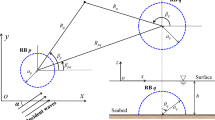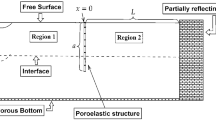Abstract
Based on linear potential theory, this study develops an analytical solution to water wave scattering by a submerged perforated reef ball. The series solutions for velocity potentials in the external and internal fluid domains of the perforated reef ball are developed using the multipole expansions and the separation of variables, respectively. The unknowns in the series solutions are determined by matching the porous boundary condition on the perforated reef ball. Also a numerical solution using three-dimensional multi-domain boundary element method (BEM) is developed. The special case of an impermeable reef ball is also examined. The calculation methods for the horizontal and vertical wave forces acting on the reef ball and the free surface elevation around the reef ball are given. The convergence of the calculation results is very rapid, and the results with five-figure accuracy are obtained using a few truncated terms in the series solution. The results by the analytical solution agree well with that by the multi-domain BEM solution. Typical calculation examples are presented to examine the effects of reef ball radius, porous effect parameter of reef ball and incident wave frequency on the wave forces and the free surface elevation. The results of analysis are valuable for engineering design and application of reef balls. The present analytical solution gives a new reliable benchmark for three-dimensional numerical models to wave interactions with perforated structures. Moreover, better understanding on wave scattering by perforated structures can be obtained during the analytically solving procedure.
















Similar content being viewed by others
References
Sherman RL, Gilliam DS, Spieler RE (2002) Artificial reef design: void space, complexity, and attractants. ICES J Mar Sci 59:196–200
Armono HD, Hall KR, Swamidas ASJ (2001) Wave field around hemisphereical shape artificial reefs used for fish habitat. In: Canadian coastal conference
Armono HD (2003) Wave transmission on submerged breakwaters made of hollow hemispherical shape artificial reefs. In: Canadian coastal conference
Armono HD (2004) Wave transmission over hemispherical shape artificial reefs. In: Marine technology conference
Buccino M, Vita ID, Calabrese M (2013) Predicting wave transmission past Reef Ball™ submerged breakwaters. J Coast Res 65:171–176
Buccino M, Vita ID, Calabrese M (2013) Engineering modeling of wave transmission of reef balls. J Waterw Port Coast Ocean Eng 140(4):1–18
Srokosz MA (1979) The submerged sphere as an absorber of wave power. J Fluid Mech 95(4):717–741
Wu GX, Eatock Taylor R (1990) The hydrodynamic forces on a submerged sphere moving in a circular path. Proc R Soc A 428:215–227
Miloh T (2001) A note on impulsive sphere motion beneath a free-surface. J Eng Math 41(1):1–11
Rahman M (2001) Simulation of diffraction of ocean waves by a submerged sphere in finite depth. Appl Ocean Res 23(6):305–317
Ursell F (2004) The waves due to a submerged sphere moving in a canal. Q J Mech Appl Mech 57(3):335–346
Wang S (1986) Motions of a spherical submarine in waves. Ocean Eng 13(3):249–271
Linton CM (1991) Radiation and diffraction of water waves by a submerged sphere in finite depth. Ocean Eng 18:61–74
Wu GX (1998) Wave radiation and diffraction by a submerged sphere in a channel. Q J Mech Appl Mech 51(4):647–666
Cadby JR, Linton CM (2000) Three-dimensional water-wave scattering in two-layer fluids. J Fluid Mech 423:155–173
Liu YY, Teng B, Cong PW, Liu CF, Gou Y (2012) Analytical study of wave diffraction and radiation by a submerged sphere in infinite water depth. Ocean Eng 51(3):129–141
Wu GX (1995) The interaction of water waves with a group of submerged spheres. Appl Ocean Res 17(3):165–184
Havelock T (1955) Waves due to a floating sphere making periodic heaving oscillations. Proc R Soc A Math Phys Eng Sci 231:1–7
Hulme A (1982) The wave forces acting on a floating hemisphere undergoing forced periodic oscillations. J Fluid Mech 121:443–463
Dong MS, Miao GP, Zhu RC, Fan J (2010) Analytic solution for wave diffraction of a submerged hollow sphere with an opening hole. J Hydrodyn 22(3):295–304
Chapman DGJ (2005) A weakly singular integral equation approach for water wave problems. PhD Thesis, University of Bristol, UK
Ursell F (1949) On the heaving motion of a circular cylinder on the surface of a fluid. Q J Mech Appl Mech 2:218–231
Thorne RC (1953) Multipole expansion in the theory of surface waves. Math Proc Camb Philos Soc 49(4):707–716
Linton CM, McIver P (2001) Handbook of mathematical techniques for wave/structure interactions. Chapman & Hall/CRC, Boca Raton
Mei CC (1978) Numerical methods in water-wave diffraction and radiation. Annu Rev Fluid Mech 10(1):393–416
Mallayachari V, Sundar V (1994) Reflection characteristics of permeable seawalls. Coast Eng 23:135–150
Teng B, Eatock Taylor R (1995) New higher-order boundary element methods for wave diffraction/radiation. Appl Ocean Res 17(2):71–77
Teng B, Ning DZ, Gou Y (2004) A fast multipole boundary element method for three-dimensional potential flow problems. Atca Oceanol Sin 23(4):747–756
Liu Y, Li HJ (2017) Iterative multi-domain BEM solution for water wave reflection by perforated caisson breakwaters. Eng Anal Bound Elem 77:70–80
Mackay E, Thies PR, Johanning L (2018) Verification of a boundary element model for wave forces on structures with porous elements. In: International conference on renewable energies offshore
Shi YY, Li ZF, Wu GX (2018) Motion of a floating body in a harbor by domain decomposition method. Appl Ocean Res 78:223–240
Yu XP (1995) Diffraction of water waves by porous breakwaters. J Waterw Port Coast Ocean Eng 121(6):275–282
Sollitt CK, Cross RH (1972) Wave transmission through permeable breakwaters. In: Proceedings of the 13th coastal engineering conference, Vancouver, pp 1827–1846
Li YC, Liu Y, Teng B (2006) Porous effect parameter of thin permeable plates. Coast Eng J 48(4):309–336
Cho IH, Kim MH (2008) Wave absorbing system using inclined perforated plates. J Fluid Mech 608:1–20
Suh KD, Kim YW, Ji CH (2011) An empirical formula for friction coefficient of a perforated wall with vertical slits. Coast Eng 58(1):85–93
Liu Y, Li YC (2016) Predictive formulas in terms of Keulegan–Carpenter numbers for the resistance coefficients of perforated walls in Jarlan-type caissons. Ocean Eng 114:101–114
Mei CC, Liu PLF, Ippen AT (1974) Quadratic loss and scattering of long waves. J Waterw Harb Coast Eng Div 100:217–239
Molin B (2011) Hydrodynamic modeling of perforated structures. Appl Ocean Res 33:1–11
Gradshteyn IS, Ryzhik IM (2007) Table of integrals, series, and products, 7th edn. Academic Press, New York
Linton CM (2011) Water waves over arrays of horizontal cylinders: band gaps and Bragg resonance. J Fluid Mech 670:504–526
Liu Y, Li HJ (2013) Analysis of oblique wave interaction with a submerged perforated semicircular breakwater. J Eng Math 83(1):23–36
Liu Y, Li HJ (2012) Analysis of wave interaction with submerged perforated semi-circular breakwaters through multipole method. Appl Ocean Res 34(1):164–172
Cho IH, Kim MH (2000) Interactions of horizontal porous flexible membrane with waves. J Waterw Port Coast Ocean Eng 126(5):245–253
Massel SR (1983) Harmonic generation by waves propagating over a submerged step. Coast Eng 7:357–380
Steinborn EO, Ruedenberg K (1973) Rotation and translation of regular and irregular solid spherical harmonics. Adv Quantum Chem 7:1–81
Ang WT (2007) A beginner’s course in boundary element methods. Universal Publishers, Boca Raton
John F (1950) On the motion of floating bodies II. Simple harmonic motions. Commun Pure Appl Math 3(1):45–101
Acknowledgements
This study was supported by the Natural Science Foundation of China under Grant Numbers 51725903 and 51490675.
Author information
Authors and Affiliations
Corresponding author
Ethics declarations
Conflict of interest
The authors declare that they have no conflict of interest.
Additional information
Publisher's Note
Springer Nature remains neutral with regard to jurisdictional claims in published maps and institutional affiliations.
Appendix: Three-dimensional multi-domain BEM solution
Appendix: Three-dimensional multi-domain BEM solution
The whole fluid domain is still divided into two regions, which are the same as those in Sect. 2. As shown in Fig. 17, the closed boundary of region 1 is defined as: S1 = SF + SD1 + SB + S∞, where SF, SD, SB and S∞ are respectively the free surface boundary, the water bottom boundary, the surface boundary of the reef ball and the far field boundary. The closed boundary of region 2 is defined as: S2 = SD2 + SB.
Applying the second Green theorem, the solution of Laplace equation can be converted into the solution of the following boundary integral equation [47]:
where x = (x, y, z) and x0 = (x0, y0, z0) are the field and source points, respectively; αj(x0) is the interior angle; nj denotes the unit normal vector on the boundary Sj and points away from fluid region j; and \(\tilde{G}_{j} \left( {\varvec{x};\varvec{x}_{0} } \right)\) is the Green function, which satisfies
For the fluid region 1, the Green function is chosen as [48]:
where \(r_{0} = [R_{0}^{2} + (z - z_{0} )^{2} ]^{1/2}\), \(r_{1} = [R_{0}^{2} + (z + z_{0} + 2h)^{2} ]^{1/2}\) and \(R_{0}^{2} = (x - x_{0} )^{2} + (y - y_{0} )^{2}\). The path of the integration on the right hand of Eq. (46) passes below the point at μ = k. We split ϕ1 as ϕ1 = ϕ0+ ϕd with ϕ0 being the incident velocity potential given in Eq. (8), and ϕd being the diffraction velocity potential to be determined. We note that both the Green function \(\tilde{G}_{1}\) and ϕd satisfy Eqs. (4)–(6). Thus, Eq. (44) can be reduced to
For the fluid region 2, the Green function only satisfying the water bottom condition is given by
Then, Eq. (44) is reduced to
The surface of the reef ball SB is divided into I elements. Both velocity potential and its normal derivative on each element are assumed to be constants. Then, all the interior angles equal to 0.5. Now, Eqs. (47) and (49) can be, respectively, discretized into the following linear equations:
where \(\phi_{j}^{m}\) and \(\bar{\phi }_{j}^{m}\) are respectively the velocity potential and its normal derivative on the center of mth element of the body surface in region j. The matrix coefficients in Eqs. (50) and (51) are given by
where δmn = 0 for m ≠ n and δmn = 1 for m = n. When the value of R0/h is greater than 0.1, the Green function in Eq. (45) is calculated using a series method according to that in John [48]. Otherwise, the Green function in Eq. (45) is calculated using the methods described in Chapman [21, Chapter 4], Linton [41, Eqs. (3.7) and (4.11)] and Liu and Li [42, Appendix].
Applying the porous boundary condition on the hemispherical shell
the system of linear equations in Eqs. (49) and (50) can be simplified as
The velocity potentials on all element of the body surface SB are determined after solving Eq. (58), and their normal derivatives are determined by Eq. (57).
The horizontal and vertical wave forces are respectively calculated by
where \(n_{x}^{m}\) and \(n_{z}^{m}\) are respectively the components along x- and z-directions of the unit normal vector on the mth element pointing to region 2, and \(S_{\text{B}}^{m}\) is the area of the mth element on SB.
Rights and permissions
About this article
Cite this article
Li, Aj., Sun, Xl., Liu, Y. et al. Analysis of water wave scattering by a submerged perforated reef ball using multipole method. Meccanica 54, 1747–1765 (2019). https://doi.org/10.1007/s11012-019-01050-y
Received:
Accepted:
Published:
Issue Date:
DOI: https://doi.org/10.1007/s11012-019-01050-y





